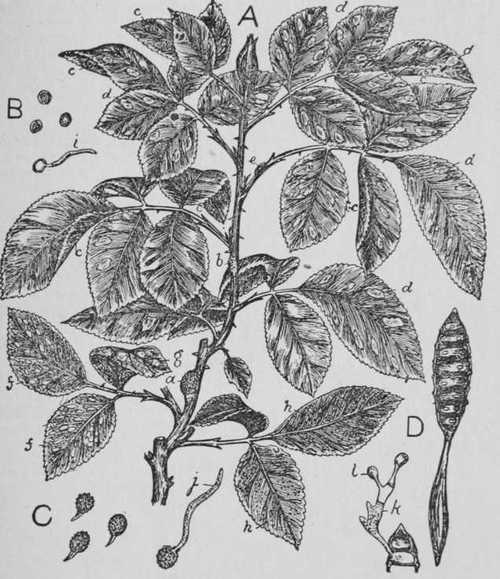Fig. 38. Orange Fungus On Roses
Description
This section is from the book "Pictorial Practical Rose Growing", by Walter P. Wright. Also available from Amazon: Pictorial Practical Rose Growing.
Fig. 38. Orange Fungus On Roses

A, a portion of the growth of a Hybrid Perpetual Rose affected with orange fungus in several stages. Aecidium stage: a, a large pustule on the previous year's wood, which has developed from a minute spot into a conspicuous, powdery, orange coloured patch. It causes distortion of the branch in most cases, always a wound; b, a pustule on the current year's wood, generally forming a large patch, and partly girdling the shoot; c, powdery, orange coloured pustules on the under side of the leaflets; d, pale yellowish patches on the upper surface of the leaves, due to the presence of fungus mycelium in the tissues, and corresponding to the orange patches on the under side; e, a pustule of the fungus on the petiole of the leaf. All these bear irregularly globose, sometimes angular by compression, aecidiospores. Uredo stage: f, the under side of the leaflets with sori or patches of powdery, brick red bodies or uredospores (indicated by orbicular spots with white centres), and small spots, at first yellowish, then black (indicated by dots), which are teleutosori; g, yellowish spots on the upper surface of the leaflet, due to the mycelium of the fungus in the tissues, and corresponding to the uredosori on the under side. Teleuto stage: h, leaflets with spots or sori of teleutospores, scattered or aggregated, orbicular, black, and minute.
B, aecidium spores, three as detached and one germinated: i, germ tube, X 300.
C, Uredospores, three detached and one germinated: j, germ tube, X 300.
D, Teleutospore consisting of several cells, with germination from a cell of the teleutospore: k, pro-mycelium; l, sporidium, X 300.
Continue to:


